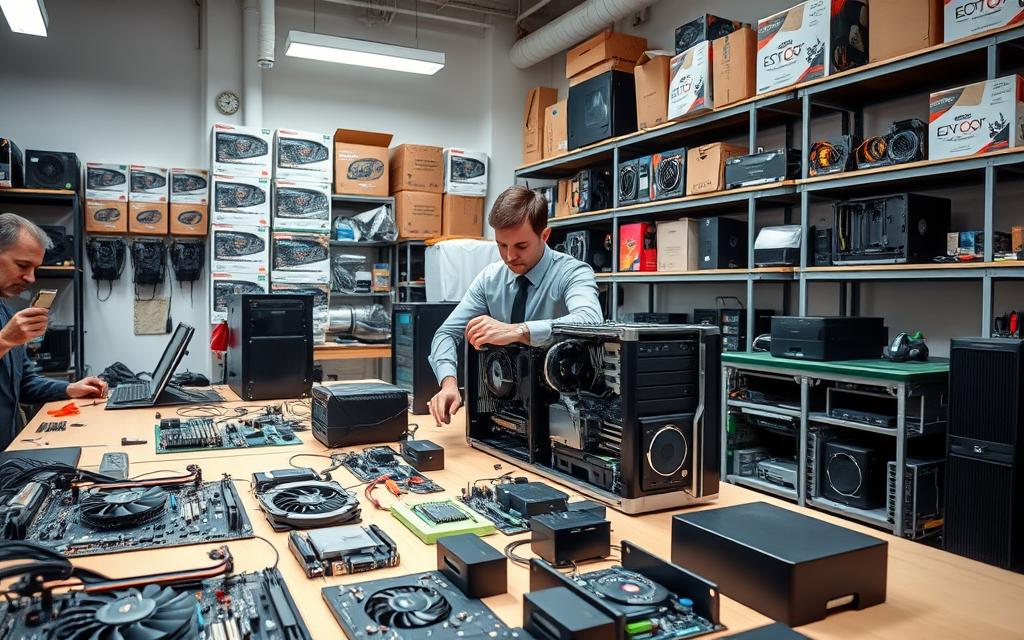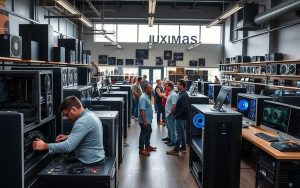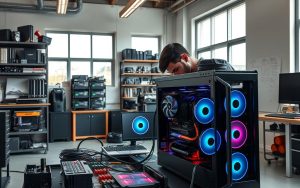Table of Contents
The PC market is booming, valued at $204.07 billion in 2024. This growth opens doors for niche customization opportunities. Combining technical skills with a solid strategy can set you apart in this competitive field.
Success in this industry requires more than just assembling hardware. Market research, niche identification, and strong supplier relationships are crucial. Brands like MAINGEAR have thrived by offering unique features, such as rear-side cable connectors.
Real-world examples, like Todd Klein’s adaptability, show the importance of staying ahead of market challenges. Diversifying services, such as reselling components, can boost revenue significantly. High-margin clients, like those purchasing $3,000 gaming systems, highlight the profitability potential.
This guide covers a 15-step roadmap to help you succeed. It emphasizes staying current with tech trends and ensuring legal compliance. With the right approach, this venture can be both a technical craft and a customer-centric service.
Introduction to Starting a PC Building Business
The custom PC industry offers a unique blend of tech expertise and entrepreneurial opportunities. However, breaking into this market requires a clear understanding of its dynamics. With giants like Dell and HP dominating, new entrants must carve out a niche by offering specialized services.
Revenue models in this sector often lean heavily on services, with companies like Vision Computers generating 60% of their income from customization and support. This shift from pure hardware sales to integrated IT solutions highlights the importance of adaptability.
Startup costs can vary significantly. High-end builds may require an initial investment of $2,000 or more, while budget-friendly alternatives can reduce this figure. Tools like magnetic screwdrivers, anti-static gear, and testing equipment are essential for quality assembly.
Legal compliance is another critical factor. Registering for a state reseller tax ID and SBA registration ensures your business operates within the law. Additionally, psychological testing for customer service staff can enhance client satisfaction, as 80% of customers value experience as much as products.
| Aspect | Details |
|---|---|
| Revenue Model | 60% services, 40% hardware |
| Startup Costs | $2,000+ for high-end builds |
| Essential Tools | Magnetic screwdrivers, anti-static gear, testing equipment |
For more insights on crafting a solid foundation, explore this detailed guide. By focusing on these elements, you can position your venture for long-term success in the competitive custom PC market.
Understanding the PC Building Market
The custom PC market is evolving rapidly, driven by diverse consumer needs. Gamers, professionals, and enterprises each have unique requirements, shaping the industry’s direction. Gamers account for 32% of the segment, while professionals and enterprises make up 28% and 40%, respectively.
Component shelf life is a critical factor. SSDs, for example, may become obsolete within 6-9 months due to advancements in technology. Pricing strategies also vary widely. Corsair’s MP600 M.2 SSD offers high performance, while HDDs remain a budget-friendly alternative.
Form factors play a significant role in design. ATX dominates with a 65% market share, but Mini-ITX is gaining traction for compact builds. Tools like PCPartPicker simplify power supply calculations, ensuring compatibility and efficiency.
Warranty trends reflect consumer expectations. Comprehensive 3-year warranties are increasingly preferred over limited 1-year options. Crypto mining continues to influence GPU pricing, while tariffs on Chinese imports impact component sourcing.
“The Steam Hardware Survey provides valuable benchmarks for gaming builds, helping manufacturers stay aligned with consumer preferences.”
Virtual fulfillment models, like NextDayPC, are challenging traditional physical setups. Understanding these dynamics is crucial for staying competitive. For deeper insights, explore this detailed guide on navigating the PC building landscape.
| Aspect | Details |
|---|---|
| Market Segments | Gamers (32%), Professionals (28%), Enterprises (40%) |
| Component Shelf Life | SSDs: 6-9 months |
| Form Factors | ATX (65%), Mini-ITX (growing) |
Identifying Your Niche in the PC Building Industry
The custom PC industry thrives on specialization, with diverse niches offering unique opportunities. Finding your niche is essential to stand out in this competitive market. Gamers, for instance, often invest $3,000+ in custom RGB systems, while medical practices spend $1,200-$1,800 monthly on service contracts.
Key niches include eSports, content creation, SMBs, education, and home theater. eSports enthusiasts demand high-performance builds with RTX 4090 GPUs, while content creators prioritize Threadripper workstations for advanced processing capabilities. SMBs and educational institutions often seek reliable, budget-friendly solutions.
Component specialization also plays a role. Liquid cooling systems cater to high-performance builds, while air cooling remains popular for budget options. Profit margins vary significantly, with high-end product lines yielding up to 40%, compared to 15% for budget builds.
Vertical integration, such as offering software loading services, can enhance profitability. MAINGEAR’s unique cable management system sets it apart, while Digital Storm’s boutique positioning appeals to premium clients. Emerging markets, like AI training rigs and blockchain nodes, present new opportunities.
“Niche-specific certifications, like NVIDIA Studio for creators, can boost credibility and sales.”
Psychological testing, as demonstrated by the Bhakta method, improves sales conversions by aligning services with customer preferences. Whether targeting B2B or B2C clients, understanding your niche is the key to success in the custom PC industry.
Conducting Market Research for Your PC Business
Effective market research is the backbone of any successful venture in the tech industry. It helps you understand customer needs, identify competitors, and uncover trends. A well-structured research process ensures your systems align with demand.
Start with a 5-step approach:
- Analyze demographics to identify your target audience.
- Conduct a SWOT analysis of competitors like Origin PC and Falcon NW.
- Audit pricing strategies to remain competitive.
- Vet suppliers for reliability and compatibility.
- Forecast trends using tools like Google Trends and SEMrush.

Tools like PCPartPicker are essential for component validation, used by 72% of builders. Google Trends reveals insights, such as a 187% YoY increase in RGB lighting searches. Competitor differentiators, like Origin PC’s 45-day lead times, highlight areas for improvement.
Compliance is critical. Research FCC regulations and RoHS standards to ensure legal adherence. Import/export data analysis aids in supply chain planning, while YouTube analytics uncover content gaps, such as build tutorials versus troubleshooting guides.
“Understanding seasonal demand patterns, like Newegg’s sales data, can optimize inventory management and marketing efforts.”
Trade show strategies, such as targeting CES for innovation or PAX West for gaming, can expand your reach. Survey methodologies, from Reddit polls to professional focus groups, provide valuable consumer insights. By leveraging these tools and strategies, you can build a solid foundation for your venture.
Crafting a Comprehensive Business Plan
A solid business plan is the foundation of any successful venture in the tech industry. It provides a clear roadmap, helping you navigate challenges and seize opportunities. Whether you’re targeting gamers, professionals, or enterprises, a well-structured plan ensures alignment with your goals.
Executive Summary
Begin with a concise overview of your business. Highlight your mission, target audience, and unique value proposition. Include 3-year ROI projections and a break-even analysis to demonstrate financial viability. This section sets the tone for the entire plan.
Product and Service Offerings
Define your product lineup and services. For example, bundle configurations like the Streamer Pro at $2,499 MSRP cater to specific needs. Offer remote support packages, such as the Silver tier at $29.99/month, to enhance customer satisfaction.
Marketing Strategy
Develop a robust strategy to reach your audience. Collaborate with influencers, offering a 20% commission structure to expand your reach. Leverage social media and content marketing to showcase your expertise and build trust.
Financial Projections
Outline your financial goals, targeting a 35% gross margin with 15% operating costs. Use tools like CAD software for custom case mod planning to optimize efficiency. Include risk analysis, such as contingency plans for component shortages.
“A detailed financial plan ensures sustainability and growth, even in a competitive market.”
Optimize inventory turnover ratios to maintain cash flow. Consider legal structures like LLC vs. S-Corp for tax benefits. Require certifications like CompTIA A+ for technicians to ensure quality and credibility.
Registering Your PC Building Business
Establishing a legal foundation is crucial for any tech venture. Proper registration ensures compliance with state and federal regulations, safeguarding your business from potential risks. The SBA.gov registration process typically takes 4-6 weeks, so plan accordingly.
Forming an LLC is a common first step. This involves obtaining an EIN and filing Articles of Organization. Multi-state operations require understanding sales tax nexus rules, which vary by location. Import licenses are essential for sourcing components overseas, ensuring smooth processing of shipments.
PCI DSS compliance is mandatory for online transactions, protecting customer data. Business insurance, with a minimum $1M liability coverage, shields your company from unforeseen events. Trademarking your brand through the USPTO TEAS system costs $250-$350 per class, offering legal protection.
EPA compliance is critical for e-waste disposal, especially if handling 25+ units annually. Adhering to OSHA workstation ergonomics standards ensures a safe work environment. Domain registration strategies, such as choosing .tech over .com, can enhance your online presence.
“Reseller certificate requirements vary by state, so research local laws to avoid penalties.”
RMA compliance ensures smooth handling of returns, while labor laws protect your team. By addressing these legal aspects, you lay a solid foundation for your venture’s success.
Sourcing Quality Components for Your PCs
Securing high-quality components is the backbone of any successful tech venture. Reliable parts ensure your product meets customer expectations and performs optimally. Building strong supplier relationships and diversifying your supply chain are critical steps in this process.
Building Relationships with Suppliers
Strong supplier relationships are essential for consistent quality and timely deliveries. Negotiate Minimum Order Quantities (MOQs) to balance cost and inventory. For example, MOQs of 50-100 units are common for components like RAM and SSDs.
Evaluate supplier tiers to ensure reliability. Tier 1 suppliers like ASUS offer premium components, while Tier 2 suppliers like ASRock provide budget-friendly options. Discuss payment terms, such as Net 30 or 2% 10-day discounts, to optimize cash flow.
Diversifying Your Supplier Base
Relying on a single supplier can be risky. Diversify your supplier base to mitigate disruptions. Explore group buying through alliances like NAED or NSCA to reduce costs. Newegg Business accounts offer additional benefits, such as bulk pricing and streamlined processing.
Counterfeit prevention is crucial. Use UPC validation techniques to ensure authenticity. Cross-shipping RMA processes can expedite returns, while drop shipping models reduce inventory overhead. Compare shipping cost structures like FOB vs CIF to minimize expenses.
| Aspect | Details |
|---|---|
| Supplier Tiers | ASUS (Tier 1), ASRock (Tier 2) |
| Payment Terms | Net 30, 2% 10-day discounts |
| Shipping Models | FOB, CIF, Drop Shipping |
By focusing on these strategies, you can ensure a steady supply of quality components for your business. This approach not only enhances your offerings but also builds trust with your customers.
Setting Up Your PC Building Workspace
Creating an efficient workspace is vital for assembling high-performance systems. A well-organized environment ensures smooth processing of builds and minimizes errors. From tools to air quality, every detail matters.
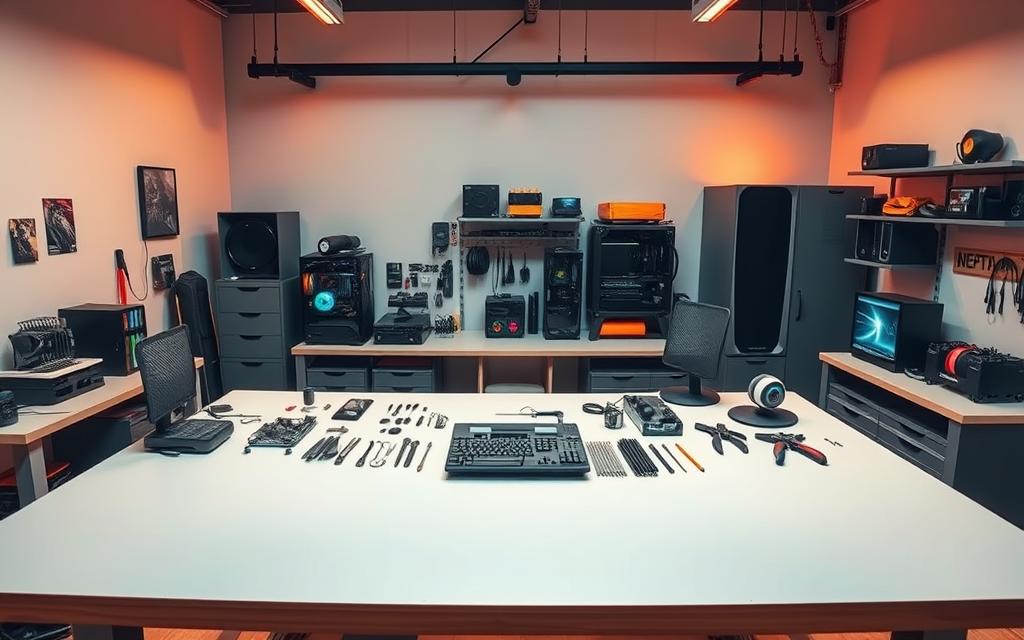
Essential Tools and Equipment
Investing in the right tools is the first step. Torx T5-T8 drivers and nylon pry tools are must-haves for precision work. Anti-static mats, priced around $159.99, protect components from static electricity, which causes 23% of failures.
Lighting is equally important. Opt for 5000K LED lights to avoid conflicts with natural light. Noise control is crucial for client consultations, with a maximum of 55dB recommended.
Creating a Dust-Free Environment
Dust can damage sensitive tech components. A Corsair 4000D Airflow case requires a 30.5L workspace, ensuring adequate ventilation. HVAC systems should maintain an optimal temperature of 65°F and humidity between 40-60%.
Air filtration is key. HEPA 13 systems outperform ionic alternatives in removing particles. A 3-zone assembly flow layout enhances efficiency, while IP cameras provide security for build verification.
Backup power is essential. A 1500VA UPS ensures uninterrupted work during outages. Compliance with ADA accessibility requirements ensures inclusivity for all clients.
Building Your Brand in the PC Market
Establishing a strong brand identity is essential for standing out in the competitive PC market. A well-defined brand not only attracts customers but also builds trust and loyalty. This section explores key strategies to create a professional online presence and leverage digital marketing effectively.
Designing a Professional Website
Your website is the face of your business. It should be visually appealing, easy to navigate, and optimized for conversions. Include a live build configurator to let customers customize their systems in real-time. Ensure PCI compliance to protect sensitive customer data during transactions.
Content strategy plays a vital role. Time-lapse videos of builds can boost engagement by 60%. Add Verified Owner badges to testimonials for social proof. Use Hotjar heatmaps to analyze user behavior and optimize the site’s UX.
Leveraging Social Media and Online Marketing
Social media is a powerful tool for reaching your target audience. Balance technical and approachable tones in your brand voice to appeal to both experts and beginners. Paid ads, such as Google PMax and Facebook Dynamic Ads, can drive traffic effectively.
Email marketing is another key strategy. Implement abandoned cart flows to recover 22% of lost sales. Collaborate with influencers by offering seeding kits with a $1,500 budget. Focus on SEO for high-value keywords like “custom gaming PC,” which has a $4.72 CPC.
In case of crises, have recall response protocols in place. Regularly monitor analytics to refine your strategies and stay ahead of the competition.
| Strategy | Details |
|---|---|
| Website Features | Live build configurator, PCI compliance |
| Content Engagement | Time-lapse videos, Verified Owner badges |
| Paid Ads | Google PMax, Facebook Dynamic Ads |
“A strong online presence is the cornerstone of modern branding. It’s not just about visibility—it’s about creating meaningful connections with your audience.”
Marketing Your PC Building Services
Marketing your custom PC services effectively can drive significant growth and customer engagement. In a competitive tech landscape, strategic promotion ensures your offerings stand out. From influencer collaborations to creative giveaways, a well-rounded approach can amplify your brand’s visibility.
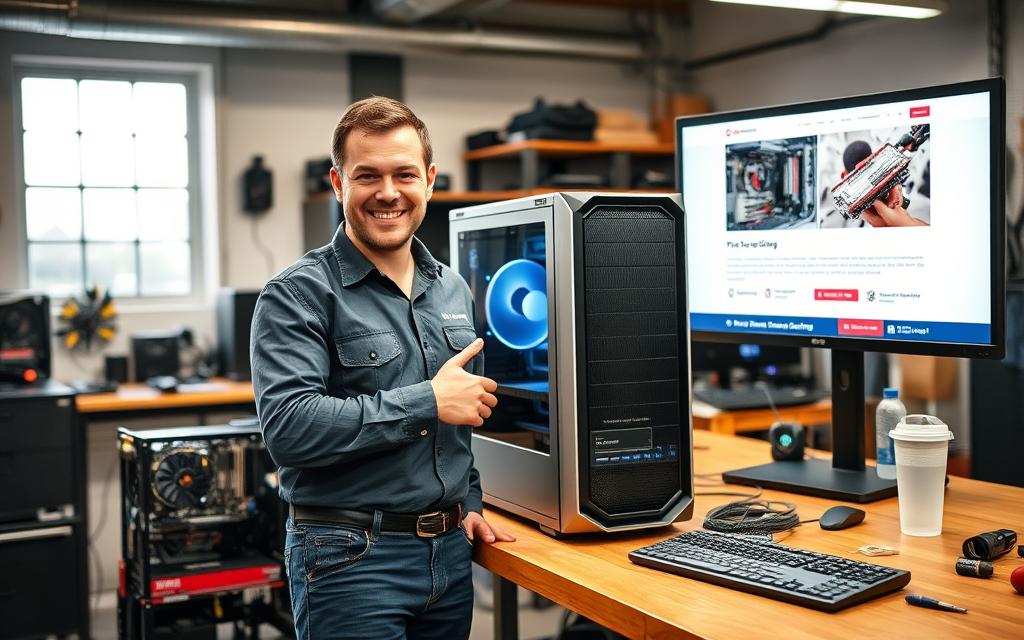
Collaborating with Influencers
Influencers play a pivotal role in modern marketing. Partnering with micro-influencers, who have 10k-50k followers, can yield high engagement at a lower cost. Affiliate programs offering 8% recurring commissions incentivize long-term partnerships.
Platforms like Twitch allow for interactive integrations, such as !pcbuild commands, to engage gaming communities. High-profile collaborations, like Linus Tech Tips sponsorships, can cost $25k+ per video but offer substantial reach.
Offering Promotions and Giveaways
Promotions and giveaways are powerful tools for attracting customers. Holiday bundles, like Black Friday doorbusters, create urgency and boost sales. Referral incentives, such as $100 store credits, encourage word-of-mouth marketing.
Limited-edition products, like NZXT case SKUs, add exclusivity. Unboxing experiences with custom packaging designs enhance customer satisfaction. AR previews and WebGL 3D configurators provide immersive shopping experiences.
“A well-executed marketing strategy not only attracts customers but also builds lasting brand loyalty.”
| Strategy | Details |
|---|---|
| Micro-Influencers | 10k-50k followers, high engagement |
| Affiliate Programs | 8% recurring commissions |
| Holiday Bundles | Black Friday doorbusters |
| Referral Incentives | $100 store credit |
By combining these strategies, you can create a robust marketing plan that resonates with your target audience. This approach ensures your services remain competitive in the ever-evolving tech industry.
Providing Exceptional Customer Service
Delivering outstanding customer experiences is key to thriving in the tech industry. Ensuring your systems meet high standards and offering reliable support can set your business apart. From rigorous testing to comprehensive warranty options, every step should prioritize customer satisfaction.
Quality Assurance and Testing
Quality assurance begins with thorough testing. Burn-in tests, such as 24-hour Prime95 and FurMark runs, ensure your systems are stable under heavy loads. Detailed documentation, including searchable PDF manuals, helps customers understand their builds.
Proactive monitoring tools, like HWInfo dashboards, provide real-time insights into system performance. This approach minimizes post-sale issues and builds trust with your clients.
Post-Sale Support and Warranty Services
Post-sale support is crucial for maintaining customer loyalty. Vision Computers’ remote DVD burning service is an example of innovative services that add value. Offering a 72-hour SLA for RMA processing ensures quick resolutions for hardware issues.
Warranty tiers, such as Platinum (5 years), Gold (3 years), and Silver (1 year), cater to diverse customer needs. Remote support tools like TeamViewer and Splashtop enable efficient troubleshooting, while uptime guarantees of 99.95% appeal to enterprise clients.
| Warranty Tier | Duration |
|---|---|
| Platinum | 5 years |
| Gold | 3 years |
| Silver | 1 year |
An escalation matrix with L1-L3 support tiers ensures complex issues are resolved promptly. Knowledge bases featuring video tutorials with timestamp chapters empower customers to troubleshoot independently.
Loyalty programs, like annual tune-up discounts, encourage repeat business. By mapping the customer journey and timing NPS surveys, you can continuously improve your services.
“Exceptional customer service isn’t just about solving problems—it’s about creating memorable experiences that build trust and loyalty.”
Managing Operations and Scaling Your Business
Efficient operations are the backbone of scaling any tech venture. Streamlining processes ensures sustainable growth in the competitive market. This section explores strategies for inventory management and expanding your product line to drive success.

Inventory Management
Effective inventory management is crucial for maintaining smooth operations. Implementing Just-In-Time (JIT) inventory systems with a 2-week buffer stock formula minimizes storage costs and ensures timely processing of orders. Tools like Fishbowl Inventory software simplify tracking and forecasting for SMBs.
Bill of Materials (BOM) management is another key aspect. Using Altium for detailed tracking outperforms basic Excel sheets, especially for complex builds. Forecasting methods like Winter’s Triple Exponential Smoothing help predict demand accurately, reducing overstock or shortages.
Dropshipping models, synced with platforms like Newegg API, streamline order fulfillment. This approach reduces overhead while maintaining customer satisfaction. GPU lead times, often 6-8 weeks during launches, highlight the importance of proactive planning.
Expanding Your Product Line
Scaling your business involves diversifying offerings and optimizing resources. Staffing decisions should balance certifications and experience, ensuring a skilled workforce. Expansion paths like prebuilt systems versus Bring-Your-Own-Device (BYOD) models cater to different customer needs.
Vertical integration, such as launching a custom loop cooling division, adds value and differentiates your brand. Acquisition strategies, like buying local repair shops, can expand your market presence quickly. Franchising with territory exclusivity clauses ensures controlled growth.
Automation plays a pivotal role in scaling. AI chatbots for configurators enhance customer experience while reducing manual workload. Embracing these strategies ensures your venture remains competitive in the evolving technology landscape.
| Strategy | Details |
|---|---|
| JIT Inventory | 2-week buffer stock formula |
| BOM Management | Altium vs Excel tracking |
| Forecasting | Winter’s Triple Exponential Smoothing |
| Dropshipping | Syncing with Newegg API |
“Operational efficiency isn’t just about cutting costs—it’s about creating systems that scale seamlessly with your growth.”
Staying Updated with Industry Trends
Staying ahead in the tech industry requires constant adaptation and learning. The rapid pace of innovation means that what’s relevant today might be obsolete tomorrow. To thrive, you must actively engage with industry trends, attend key events, and invest in continuous skill development.
Attending Industry Events and Conferences
Industry events like CES, Computex, and DreamHack offer invaluable insights into emerging technology. These gatherings showcase cutting-edge innovations, from new hardware releases to software advancements. For example, winning a CES Innovation Award can significantly boost sales and brand credibility.
Webinars and virtual conferences are also essential. A 90-day content calendar ensures you stay informed about the latest developments. These platforms provide opportunities to network with industry leaders and gain firsthand knowledge of market trends.
Continuous Learning and Skill Development
In the tech world, learning never stops. Certifications like CompTIA A+ and Cisco CCNA are critical for staying relevant. These credentials need renewal every three years, ensuring professionals remain up-to-date with the latest systems and practices.
Beta programs, such as NVIDIA Early Access, allow you to test new products before they hit the market. This hands-on experience can give you a competitive edge. Additionally, OEM training programs, like those offered by ASUS Republic of Gamers, provide specialized knowledge tailored to specific hardware.
“Continuous learning is not just an option—it’s a necessity in the ever-evolving tech landscape.”
Academic partnerships and mentorship programs, such as those through SCORE.org, further enhance your expertise. Allocating 5% of revenue to research and development ensures your business remains innovative and forward-thinking.
Conclusion: Building a Successful PC Building Business
Achieving success in the tech industry requires a blend of passion and strategic planning. Companies like MAINGEAR have proven this, reaching $100M+ in annual revenue while maintaining a 4.7/5 rating across 500+ Trustpilot reviews. Their journey highlights the importance of adaptability, such as planning for PCIe 5.0 transitions, and fostering community through local LAN parties.
To build a thriving business, focus on niche specialization, strong supplier relationships, and compliance. Growth metrics, like a 20% YoY revenue target, can guide your progress. Sustainability efforts, such as pursuing EPEAT certification, and philanthropic initiatives, like STEM scholarships, further enhance your brand’s value.
Finally, consider exit strategies, with acquisition multiples ranging from 4-6x EBITDA. Ensure your foundation is solid with a business license, insurance, and a professional website. As Tarun Bhakta aptly said, “Building PCs is art with ROI.” Take the next step—apply for an SBA loan and turn your vision into reality.
FAQ
What are the key steps to enter the PC building industry?
Begin by understanding the market, identifying your niche, and conducting thorough research. Craft a detailed business plan, register your company, and source quality components. Set up a workspace, build your brand, and focus on marketing and customer service to grow your venture.
How do I identify my niche in the PC building market?
Analyze customer needs and trends. Focus on areas like gaming PCs, workstations, or budget-friendly systems. Tailor your services to meet specific demands, such as high-performance processing or custom designs, to stand out in the industry.
Why is market research important for a PC building business?
Research helps you understand customer preferences, competitor strategies, and pricing trends. It ensures your product offerings align with market demands, giving you a competitive edge.
What should be included in a PC building business plan?
Include an executive summary, product and service details, marketing strategies, and financial projections. A well-structured plan guides your operations and attracts potential investors.
How do I source quality components for my PCs?
Build strong relationships with reliable suppliers and diversify your supplier base. This ensures consistent quality and reduces risks associated with supply chain disruptions.
What tools are essential for setting up a PC building workspace?
Invest in anti-static tools, screwdrivers, cable management supplies, and testing equipment. Maintain a dust-free environment to ensure the quality of your builds.
How can I effectively market my PC building services?
Leverage social media, design a professional website, and collaborate with influencers. Offer promotions and giveaways to attract customers and build brand awareness.
What role does customer service play in a PC building business?
Exceptional service builds trust and loyalty. Focus on quality assurance, thorough testing, and providing post-sale support, including warranty services, to enhance customer satisfaction.
How do I manage operations and scale my PC building business?
Implement efficient inventory management systems and consider expanding your product line. Streamline processes to handle increased demand as your business grows.
How can I stay updated with industry trends in PC building?
Attend industry events, conferences, and trade shows. Engage in continuous learning and skill development to stay ahead of technological advancements and market shifts.


